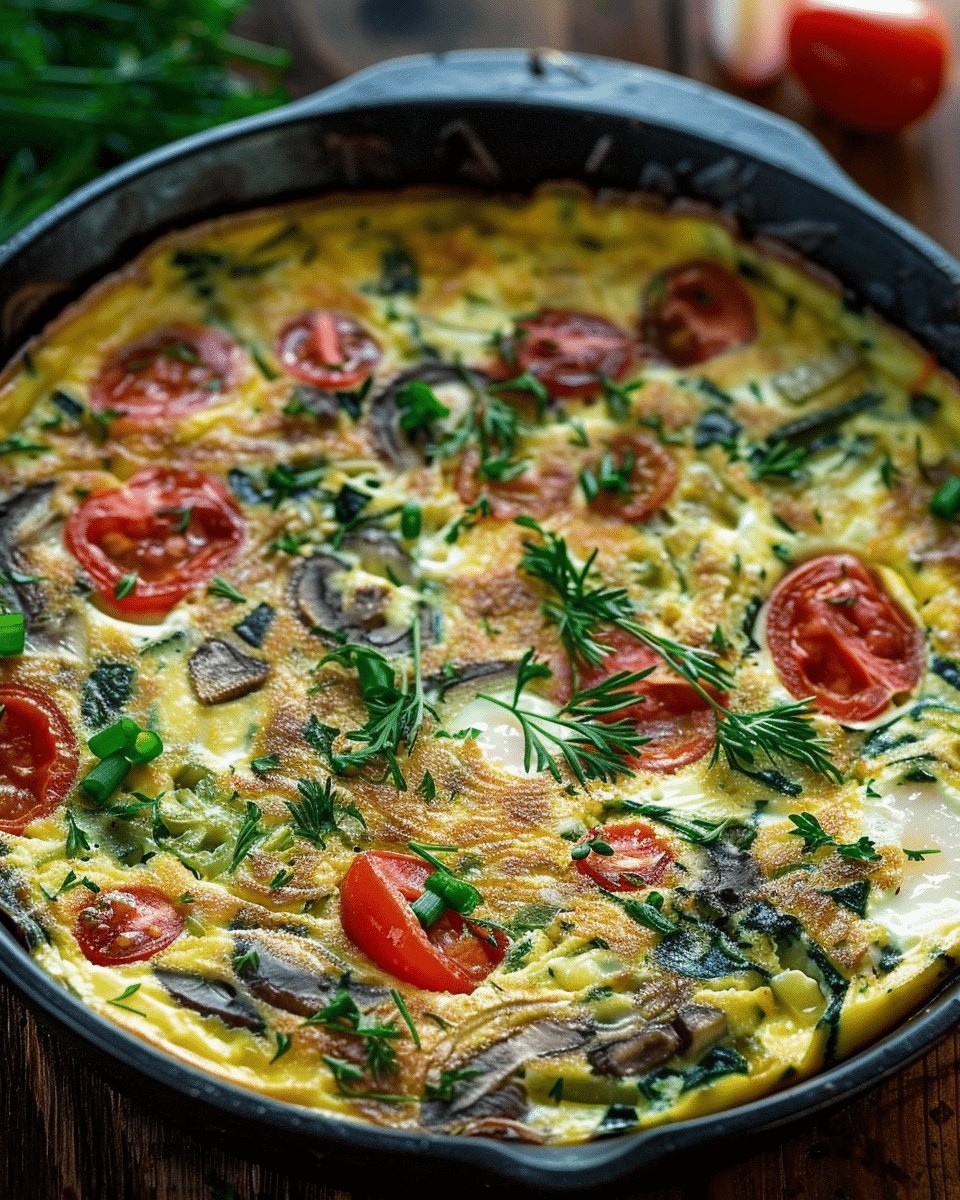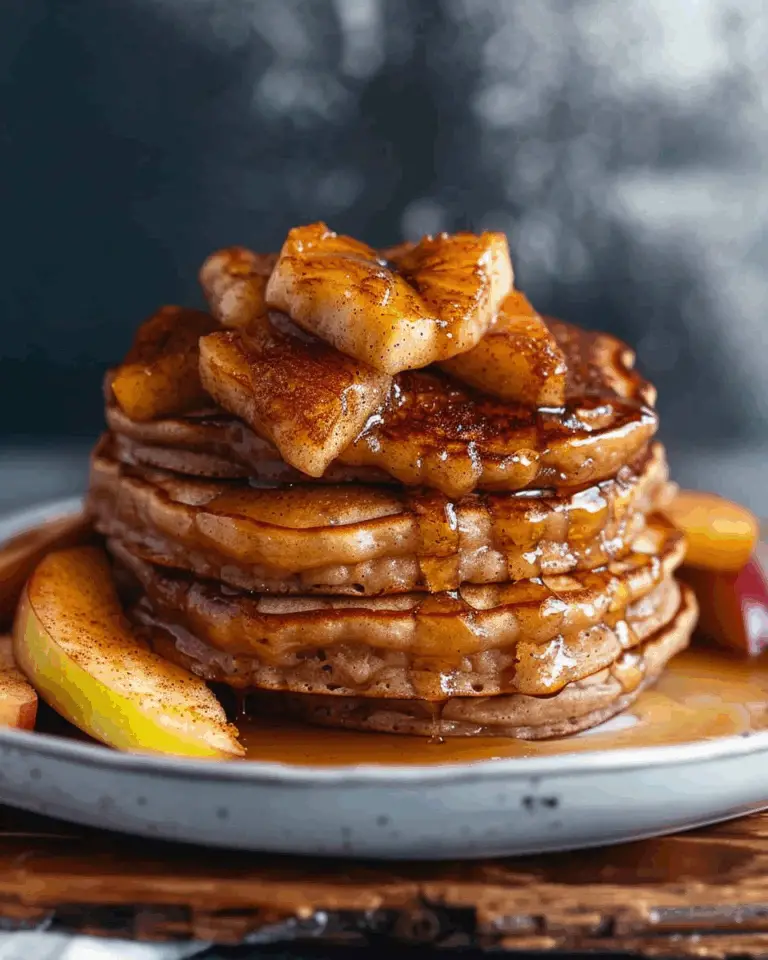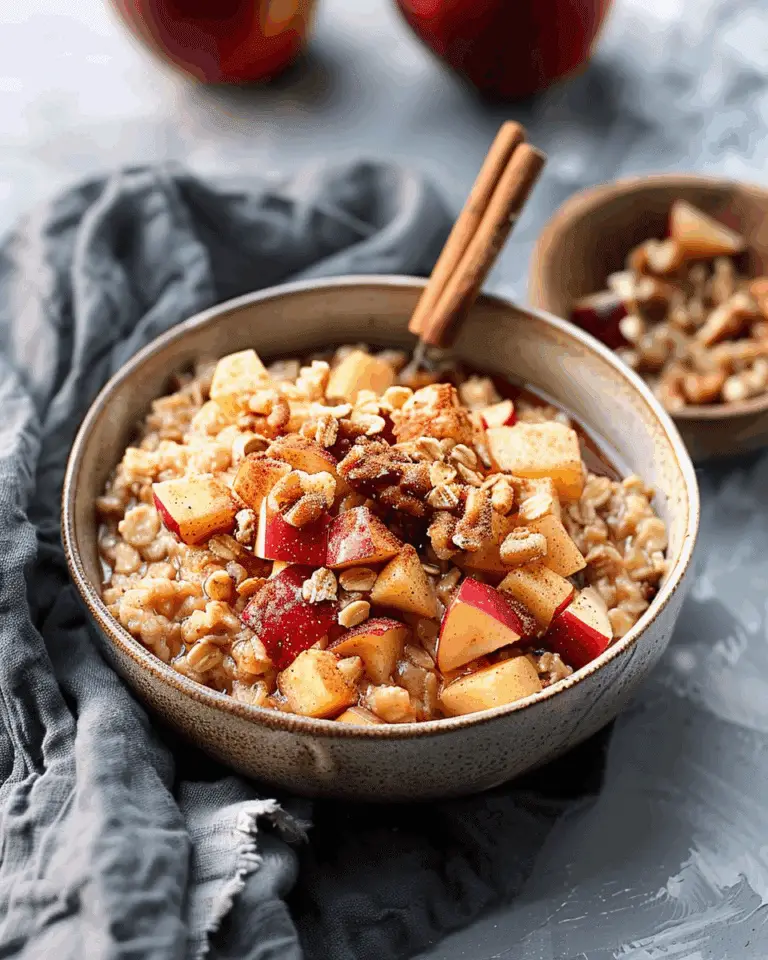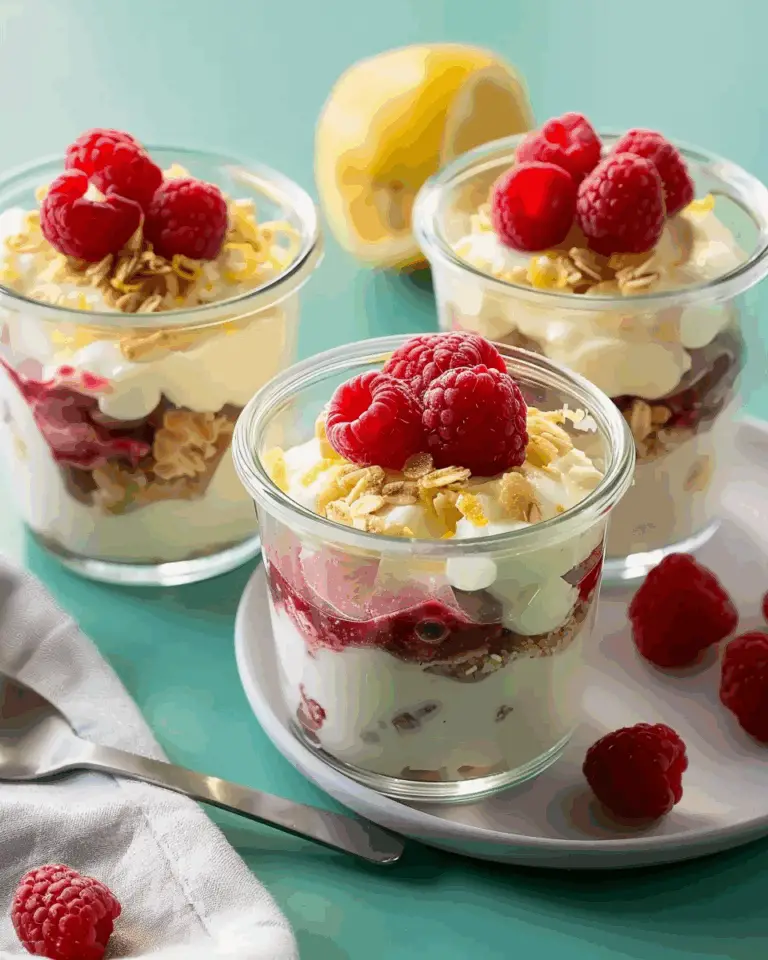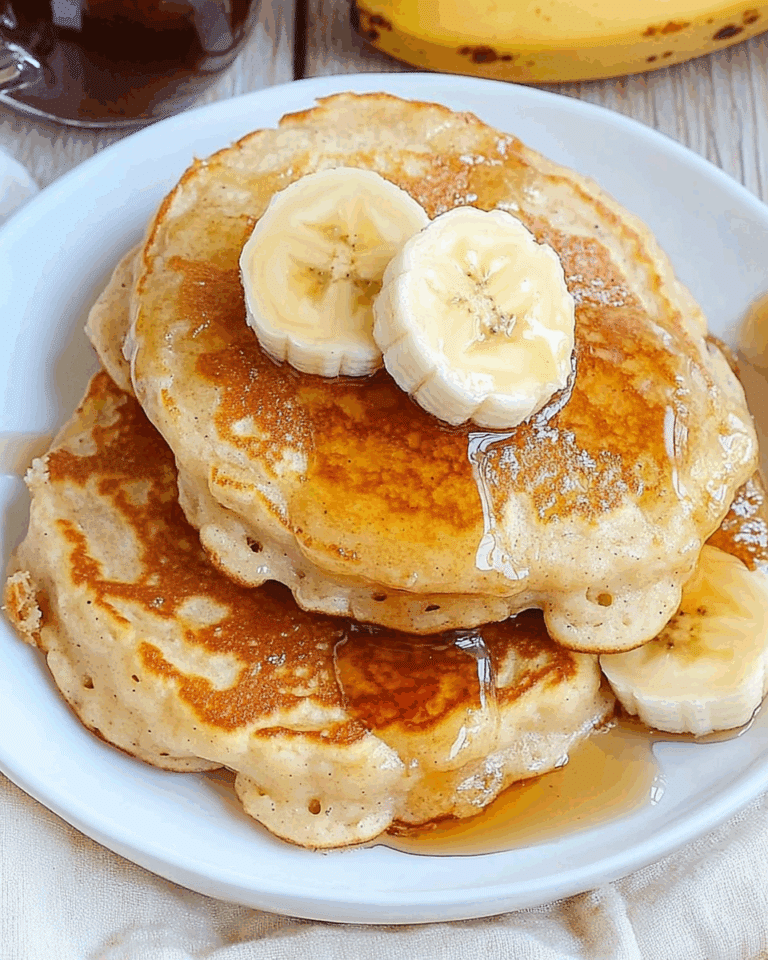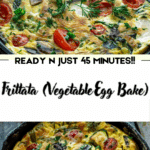Why You’ll Love Frittata Recipe
It’s quick and simple: You whisk eggs, sauté veggies, pour in the egg mixture, then bake.
Highly adaptable: Use whatever vegetables you have on hand and tailor the herbs and cheese to your taste.
Works any time of day: Great for breakfast, brunch or dinner.
One‑pan convenience: Sauté and bake in the same skillet, minimal cleanup.
Ingredients
(Tip: You’ll find the full list of ingredients and measurements in the recipe card below.)
Basic frittata base:
-
large eggs
-
milk (or almond milk or other milk)
-
garlic, minced
-
sea salt and freshly ground black pepper
-
extra‑virgin olive oil
For example vegetable variations you might add:
-
chopped scallions, chopped broccoli or broccolini, smoked paprika, crumbled feta cheese
-
chopped shallot, roasted red bell peppers, spinach, crumbled feta
-
spring onions or scallions, chopped asparagus, thawed peas, mini mozzarella balls, feta, chopped tarragon or chives
-
chopped shallot, mixed mushrooms, chopped tarragon, grated pecorino cheese
-
chopped shallot, halved cherry tomatoes, halved mini mozzarella balls, fresh basil leaves
Directions
-
Preheat your oven to 400 °F (≈ 200 °C).
-
In a bowl, whisk together the eggs, milk, garlic, salt and pepper until well combined. Set aside.
-
Choose your vegetable variation. Heat olive oil in a 10‑ or 12‑inch oven‑safe skillet over medium heat. Add the chopped vegetables (and shallot or scallion if using), season with salt and pepper, and sauté until the veggies are tender but still vibrant.
-
Once vegetables are ready, stir in any herbs or spices (for example tarragon, smoked paprika). Pour the egg mixture into the skillet over the vegetables. Gently shake the pan so the eggs distribute evenly around the veggies.
-
Sprinkle the cheese (if using) evenly on top. Transfer the skillet to the preheated oven and bake for about 15‑20 minutes, or until the eggs are set and the top is lightly golden around the edges.
-
Remove from oven, allow to cool slightly (so it sets fully and is easier to slice), then cut into wedges and serve with extra fresh herbs or toppings (such as avocado, yogurt, pesto or salsa) if you like.
Servings and timing
Serves: about 3‑4 people for the basic version.
Prep time: ~5 minutes.
Cook time (oven): ~25 minutes.
Total time: ~30 minutes.
Variations
-
Swap the vegetables: use summer squash, zucchini, bell peppers, spinach, kale, or whatever’s in season.
-
Change the cheese: feta, mozzarella, pecorino, goat cheese, cheddar — choose your favorite.
-
Add herbs/spices: basil, chives, tarragon, parsley, smoked paprika, chili flakes for heat.
-
Make a meat version: you could sauté diced cooked sausage or chopped ham with the veggies for a non‑vegetarian version.
-
Try individual servings: Use a smaller 6‑inch skillet or muffin tin to make mini frittatas (reduce eggs accordingly, check timing sooner).
Storage/Reheating
-
Store: Allow to cool, then cover and refrigerate for up to about 3‑4 days.
-
Reheat: Rewarm individual slices in a 350 °F (≈175 °C) oven for ~8‑10 minutes, or microwave gently until warmed through.
-
Freezing: You can freeze cooled slices (wrapped) for longer storage; thaw overnight in the fridge and reheat as above.
FAQs
How do I know when it’s done?
The frittata is done when the eggs are fully set (no runny liquid) and a little golden around the edges. The center should not jiggle. If you see it moving like a floppy custard, give it a few more minutes.
Can I use a non‑stick or stainless steel pan instead of cast iron?
Yes, you can. The recipe suggests a cast‑iron skillet because it goes from stovetop to oven and retains heat well, but any oven‑safe skillet will work. Just ensure it’s safe for the oven at 400 °F.
Can I make it without cheese?
Absolutely. You can omit the cheese or use a dairy‑free alternative if you’re vegan or avoiding dairy. The vegetables and eggs still provide great flavor and texture.
What if I don’t have almond milk?
No problem — you can use any milk you prefer (dairy or non‑dairy) or even just water if needed. The milk helps lighten the egg mixture slightly but isn’t strictly mandatory.
Can I make this ahead of time for brunch?
Yes — you can make it ahead, cool completely, and refrigerate. At serving time, reheat in the oven until warmed through and top with fresh herbs or other toppings.
How many eggs should I use for a larger pan?
The basic recipe uses 6 eggs in a 10‑inch skillet. If you use a larger 12‑inch skillet you might increase to 8 eggs to maintain thickness and texture.
Can I add potatoes or grains?
You certainly can add cooked diced potatoes or even cooked grains like farro for a heartier version. Just ensure they’re pre‑cooked so they’ll be tender when the frittata finishes baking.
Can I finish the frittata under the broiler instead of baking?
Yes — some cooks prefer to finish under the broiler for a golden top. Just keep a close eye to avoid burning; move the skillet away if edges brown too quickly.
Is this suitable for dinner as well as breakfast?
Yes — while it’s perfect for brunch, it works nicely for dinner too. Serve with a salad or crusty bread and you have a complete meal.
How do I make sure my veggies are evenly distributed?
Before pouring in the egg mixture, spread the sautéed vegetables evenly in the skillet. Once the eggs go in you shouldn’t stir much, so the veggie placement before baking is important for even bites.
Conclusion
This frittata recipe delivers a reliable, flexible, vegetable‑packed egg dish that works across meals and occasions. With minimal fuss and maximum flavor, you’ll appreciate how easy it is to customize based on what’s in your fridge or seasonal produce. Whether you go with broccoli‑feta, spring asparagus‑pea, caprese or a mushroom‑tarragon twist, you’ll end up with something delicious, satisfying and ready to enjoy.

Frittata (Vegetable Egg Bake)
5 Stars 4 Stars 3 Stars 2 Stars 1 Star
No reviews
- Author: Mia
- Total Time: 25 minutes
- Yield: 4 servings
- Diet: Vegetarian
Description
This easy vegetable frittata is a versatile, healthy dish made with eggs, fresh vegetables, and herbs. It’s perfect for breakfast, brunch, or even a light dinner.
Ingredients
- 6 large eggs
- 1/4 cup milk (any kind)
- 1/2 teaspoon sea salt
- Freshly ground black pepper
- 1 tablespoon olive oil
- 1/2 cup chopped scallions
- 1 cup chopped asparagus (about 8 spears)
- 1/2 cup chopped zucchini
- 1/2 cup halved cherry tomatoes
- 1/4 cup crumbled feta cheese
- 1/4 cup chopped fresh basil
Instructions
- Preheat the oven to 400°F.
- In a medium bowl, whisk together the eggs, milk, salt, and several grinds of pepper. Set aside.
- Heat the olive oil in a 10-inch cast-iron or oven-safe nonstick skillet over medium heat. Add the scallions and cook for 1 minute. Add the asparagus and zucchini and cook for 2 to 3 minutes, until slightly tender.
- Pour in the egg mixture and cook without stirring for 1 to 2 minutes, until the edges begin to set.
- Sprinkle the cherry tomatoes, feta cheese, and basil evenly over the top. Transfer the skillet to the oven.
- Bake for 10 to 12 minutes, or until the eggs are set and lightly golden on top.
- Remove from the oven and let sit for a few minutes before slicing and serving.
Notes
- Use any seasonal vegetables you have on hand—bell peppers, spinach, or mushrooms also work well.
- Frittata is delicious hot or at room temperature—perfect for make-ahead meals.
- Serve with a green salad or toast for a complete meal.
- Prep Time: 10 minutes
- Cook Time: 15 minutes
- Category: Breakfast, Brunch, Main Dish
- Method: Baked
- Cuisine: Italian
Nutrition
- Serving Size: 1/4 of recipe
- Calories: 180
- Sugar: 3g
- Sodium: 350mg
- Fat: 12g
- Saturated Fat: 4g
- Unsaturated Fat: 7g
- Trans Fat: 0g
- Carbohydrates: 6g
- Fiber: 1g
- Protein: 12g
- Cholesterol: 210mg

